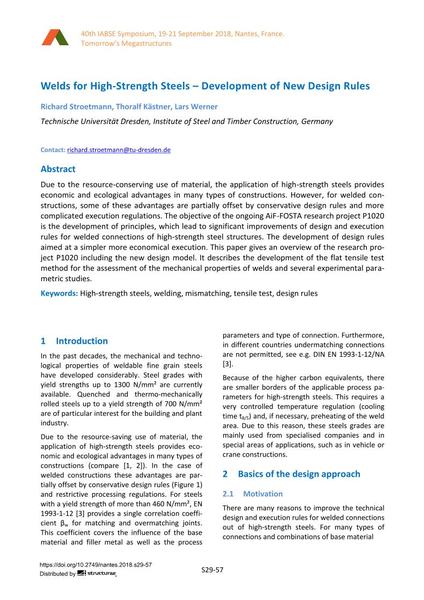Welds for High-Strength Steels – Development of New Design Rules

|
|
|||||||||||
Bibliografische Angaben
| Autor(en): |
Richard Stroetmann
(Technische Universität Dresden, Institute of Steel and Timber Construction, Germany)
Thoralf Kästner (Technische Universität Dresden, Institute of Steel and Timber Construction, Germany) Lars Werner (Technische Universität Dresden, Institute of Steel and Timber Construction, Germany) |
||||
|---|---|---|---|---|---|
| Medium: | Tagungsbeitrag | ||||
| Sprache(n): | Englisch | ||||
| Tagung: | IABSE Symposium: Tomorrow’s Megastructures, Nantes, France, 19-21 September 2018 | ||||
| Veröffentlicht in: | IABSE Symposium Nantes 2018 | ||||
|
|||||
| Seite(n): | S29-57 | ||||
| Anzahl der Seiten (im PDF): | 8 | ||||
| DOI: | 10.2749/nantes.2018.s29-57 | ||||
| Abstrakt: |
Due to the resource-conserving use of material, the application of high-strength steels provides economic and ecological advantages in many types of constructions. However, for welded con- structions, some of these advantages are partially offset by conservative design rules and more complicated execution regulations. The objective of the ongoing AiF-FOSTA research project P1020 is the development of principles, which lead to significant improvements of design and execution rules for welded connections of high-strength steel structures. The development of design rules aimed at a simpler more economical execution. This paper gives an overview of the research pro- ject P1020 including the new design model. It describes the development of the flat tensile test method for the assessment of the mechanical properties of welds and several experimental para- metric studies. |
||||
| Stichwörter: |
Schweißen hochfeste Stähle Zugversuch
|
||||
